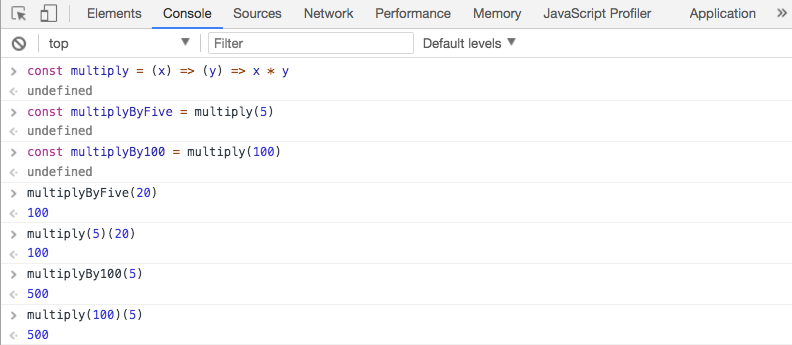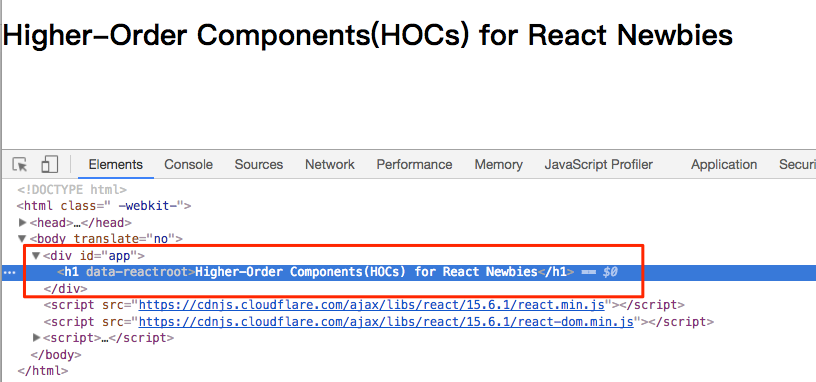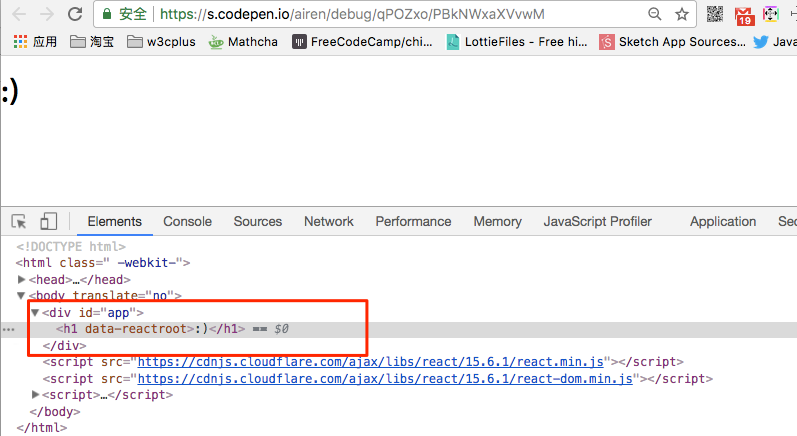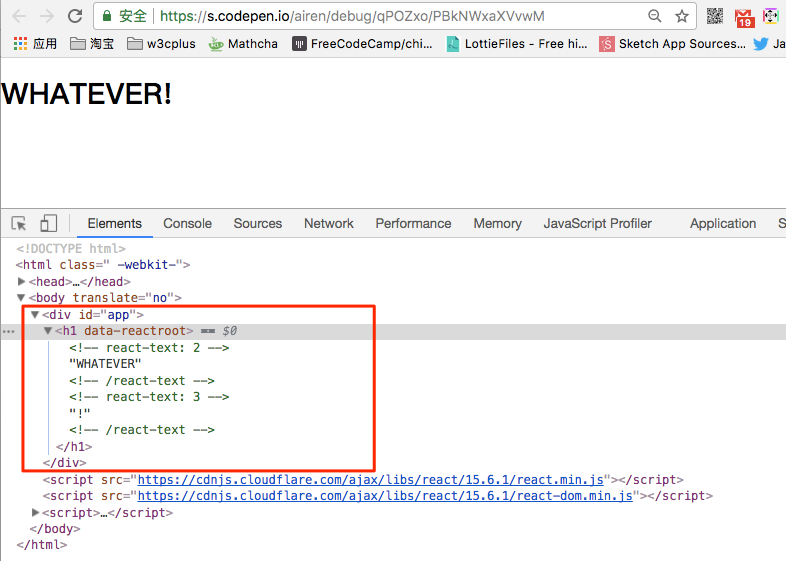面向初学者的高阶组件教程
特别声明:本文转载@冉余翻译@Brandon Newton的《》一文,如需转载,烦请注明原文出处:
谈点:一篇面向初学者的 HOC 介绍。高阶组件听起来挺唬人的,只看名字恐怕不是那么容易明白究竟是何物,而且通常来讲高阶组件并不是组件,而是接受组件作为参数,并且返回组件的函数。早期利用 ES5 的 mixin 语法来做的事,基本都可以使用高阶组件代替,而且能做的还有更多。
前言
写这篇文章的起因是其他关于**高阶组件(Higher-Order Components)**的文章,包含官方文档,都令初学者感到相当困惑。我知道有高阶组件这样一个东西,但不知道它到底有什么用。所以,想通过一篇文章来对高阶组件有一个更好的理解。
在此之前,我们需要先来讲一下 JavaScript 中的函数。
ES6 箭头函数简介
接下来将提供一些箭头函数的简单示例,如果之前没有使用过,可以认为它们与普通函数基本一致。下面的代码会展示箭头函数与普通函数的区别。
function () {
return 42
}
// 相当于:
() => 42
// 相当于:
() => {
return 42
}
function person(name) {
return { name: name }
}
// 相当于:
(name) => {
return { name: name }
}
阅读 MDN 的箭头函数文档 了解更多信息。
作为值的函数与部分调用
就像是数字、字符串、布尔值 一样,函数也是值,意味着可以像传递其他数据一样传递函数,可以将函数作为参数传递给另外一个函数。
const execute = (someFunction) => someFunction()
execute(() => alert('Executed'))
也可以在在函数中返回一个函数:
const getOne = () => () => 1
getOne()()
之所以在 getOne 后面有两个 () ,是因为第一个返回的返回值是一个函数。如下:
const getOne = () => () => 1
getOne //=> () => () => 1
getOne() //=> () => 1
getOne()() //=> 1

从函数返回函数可以帮助我们追踪初始输入函数。例如,下面的函数接受一个数字作为参数,并返回一个将该参数乘以新参数的函数:
const multiply = (x) => (y) => x * y
multiply(5)(20)
这个示例跟上述 getOne 一样,在下面这个例子,让 x = 5,y = 20。
const multiply = (x) => (y) => x * y
multiply //=> (x) => (y) => x * y
multiply(5) //=> (y) => 5 * y
multiply(5)(20) //=> 5 * 20

在只传入一个参数调用 multiply 函数时,即部分调用该函数。比如,multiply(5) 讲得到一个将其输入值乘以 5 的函数,multiply(7) 将得到一个将其输入值乘以 7 的函数。依此类推。通过部分调用可以创建一个预定义功能的新函数:
const multiply = (x) => (y) => x * y
const multiplyByFive = multiply(5)
const multiplyBy100 = multiply(100)
multiplyByFive(20) //=> 100
multiply(5)(20) //=> 100
multiplyBy100(5) //=> 500
multiply(100)(5) //=> 500

一开始看起来似乎没什么用,但是,通过部分调用这种方式可以编写可读性更高,更易于理解的代码。举个例子,可以用一种更清晰的方式来代替 style-components 的函数插入语法。
// before
const Button = styled.button`
background-color: ${({ theme }) => theme.bgColor}
color: ${({ theme }) => theme.textColor}
`
<Button theme={themes.primary}>Submit</Button>
// after
const fromTheme = (prop) => ({ theme }) => theme[prop]
const Button = styled.button`
background-color: ${fromTheme("bgColor")}
color: ${fromTheme("textColor")}
`
<Button theme={themes.primary}>Submit</Button>
我们创建一个接受一个字符串作为参数的函数 fromTheme("textColor"):它返回一个接受具有 theme 属性的对象的函数:({ theme }) => theme[prop],然后再通过初始传入的字符串 "textColor" 进行查找。我们可以做得更多,写类似的 backgroundColor 和 textColor 这种部分调用 fromTheme 的函数:
const fromTheme = (prop) => ({ theme }) => theme[prop]
const backgroundColor = fromTheme("bgColor")
const textColor = fromTheme("textColor")
const Button = styled.button`
background-color: ${backgroundColor}
color: ${textColor}
`
<Button theme={themes.primary}>Submit</Button>
高阶函数
高阶函数的定义是,接受函数作为参数的函数。如果曾经使用过类似 map 这样的函数,可能已经很熟悉高阶函数。如果不熟悉 map,它是一个数组遍历的方法,接受一个函数作为参数应用到数组中的每个元素。例如,可以像这样对一个数组作平方:
const square = (x) => x * x
[1, 2, 3].map(square) //=> [ 1, 4, 9 ]
可以实现一个我们自己的 map 版本来说明这个概念:
const map = (fn, array) => {
const mappedArray = []
for (let i = 0; i < array.length; i++) {
mappedArray.push(
// apply fn with the current element of the array
fn(array[i])
)
}
return mappedArray
}
然后再使用我们的 map 版本来对一个数组作平方:
const square = (x) => x * x
console.log(map(square, [1, 2, 3, 4, 5])) //=> [ 1, 4, 9, 16, 25 ]
译者注:我们也可以将
map方法从对象中解耦出来:
const map = (fn, array) => Array.prototype.map.call(array, fn)这样也可以像上述例子一样调用。 或者更函数式的做法,再来点柯里化:
const map = array => fn => Array.prototype.map.call(array, fn)
或者是返回一个<li>的 React 元素数组:
const HeroList = ({ heroes }) => (
<ul>
{map((hero) => (
<li key={hero}>{hero}</li>
), heroes)}
</ul>
)
<HeroList heroes=[
"Wonder Woman",
"Black Widow",
"Spider Man",
"Storm",
"Deadpool"
]/>
/*=> (
<ul>
<li>Wonder Woman</li>
<li>Black Widow</li>
<li>Spider Man</li>
<li>Storm</li>
<li>Deadpool</li>
</ul>
)*/
高阶组件
我们知道,高阶函数是接受函数作为参数的函数。在 React 中,任何返回 JSX 的函数都被称为无状态函数组件,简称为函数组件。基本的函数组件如下所示:
const Title = (props) => <h1>{props.children}</h1>
ReactDOM.render(
<Title>Higher-Order Components(HOCs) for React Newbies</Title>,
document.getElementById('app')
)

高阶组件则是接受组件作为参数并返回组件的函数。如何使用传入组件完全取决于你,甚至可以完全忽视它:
// Technically an HOC
const ignore = (anything) => (props) => <h1>:)</h1>
const IgnoreHeroList = ignore('HeroList')
ReactDOM.render(
<IgnoreHeroList />,
document.getElementById('app')
)

可以编写一个将输入转换成大写的 HOC:
const yell = (PassedComponent) =>
({ children, ...props }) =>
<PassedComponent {...props}>
{children.toUpperCase()}!
</PassedComponent>
const Title = (props) => <h1>{props.children}</h1>
const AngryTitle = yell(Title)
ReactDOM.render(
<AngryTitle>Whatever</AngryTitle>,
document.getElementById('app')
)

你也可以返回一个有状态组件,因为 JavaScript 中的类不过是函数的语法糖。这样就可以使用到 React 生命周期的方法,比如 componentDidMount。这是 HOCs 真正有用的地方。我们现在可以做一些稍微有趣点的事,比如将 HTTP 请求的结果传递给函数组件。
const withGists = (PassedComponent) =>
class WithGists extends React.Component {
state = {
gists: []
}
componentDidMount() {
fetch("https://api.github.com/gists/public")
.then((r) => r.json())
.then((gists) => this.setState({
gists: gists
}))
}
render() {
return (
<PassedComponent
{...this.props}
gists={this.state.gists}
/>
)
}
}
const Gists = ({ gists }) => (
<pre>{JSON.stringify(gists, null, 2)}</pre>
)
const GistsList = withGists(Gists)
<GistsList />
// => Before api request finishes:
// <Gists gists={[]} />
//
// => After api request finishes:
// <Gists gists={[
// { /* … */ },
// { /* … */ },
// { /* … */ }
// ]} />
withGists 会传递 gist api 调用的结果,并且你可以在任何组件上使用。点击这里 可以看到一个更加完整的例子。
结论:高阶组件是
react-redux 也是使用 HOC, connect 将应用 store 的值传递到“已连接” 的组件。它还会执行一些错误检查和组件生命周期优化,如果手动完成将导致编写大量重复代码。
如果你发现自己在不同地方编写了大量的代码,那么也可以将代码重构成可重用的 HOC。
HOCs 非常具有表现力,可以使用它们创造很多很酷的东西。
尽可能地保持你的 HOC 简单,不要编写需要阅读长篇大论才能理解的代码。
附加练习
下面有一些练习,来巩固对 HOC 的理解:
- 写一个反转其输入的 HOC
- 编写一个HOC,将 API 中的数据提供给组件
- 写一个HOC来实现
shouldComponentUpdate,以避免更新。 - 编写一个 HOC,使用
React.Children.toArray对传入组件子元素进行排序。Sneaker Bar Detroit (SBD)
